 It’s October 29, 2015, the third anniversary of the sinking of the Tall Ship Bounty.
It’s October 29, 2015, the third anniversary of the sinking of the Tall Ship Bounty.
Bounty, built in 1960 as a replica of the famous HMS Bounty, sank off the coast of North Carolina during Hurricane Sandy. A daring and dangerous US Coast Guard rescue operation saved 14 people from the ship. But two were lost, the ship’s beloved long-time captain, Robin Walbridge, and crew member Claudene Christian.
I’m obviously drawn to this story because it concerns shipwreck — an altogether human and heartbreaking story of adventure, hard work, camaraderie, survival, and loss.
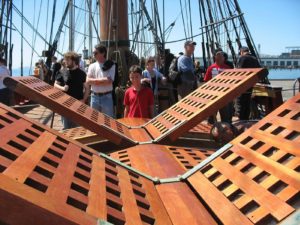 But the story also stays with me because Bounty was one of the few ships I’d ever set foot on.
But the story also stays with me because Bounty was one of the few ships I’d ever set foot on.
In the summer of 2008, our extended family converged on San Francisco to celebrate my father-in-law’s 70th birthday. As it happened, the Tall Ships Festival was going on in town at the same time, and Bounty was part of it. I persuaded my older son, then 12 years old, to go with me.
I was already deep into the project that would become Landfalls, and I wanted to see an 18th-century ship, or a reasonable facsimile thereof. This seemed my best chance for doing so.
 We spent about half an hour on the ship. We walked all over, entering or peeking into every space they allowed us to explore. I took a few pictures (some of which I’ve reproduced here), but mostly I tried to soak in something — anything — about what it might be like, what it might have been like, to live and serve aboard such a vessel.
We spent about half an hour on the ship. We walked all over, entering or peeking into every space they allowed us to explore. I took a few pictures (some of which I’ve reproduced here), but mostly I tried to soak in something — anything — about what it might be like, what it might have been like, to live and serve aboard such a vessel.
Of course we were safely moored in San Francisco Bay, and the place was crawling with other Tall Ships Festival ticketholders, so my imagination was constrained. But I did come away with a keener appreciation for the ship’s beauty both inside and out, for the complexity of its many moving parts, and for its aliveness underfoot as I made my way across its deck and through its interior.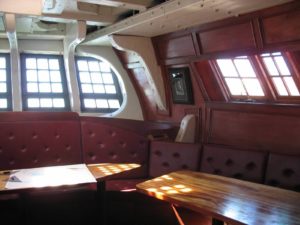
I also picked up a flier. Berths were being offered to paying passengers. In fact, at the conclusion of the Tall Ships Festival, you could join the ship for a two- or three-day sail from San Francisco to Monterey. I was sorely tempted to ask if there was still space available. The Lapérouse expedition had gone to Monterey; I was still struggling to write that chapter. How amazing would it be to sail into that bay on a ship, as they had?
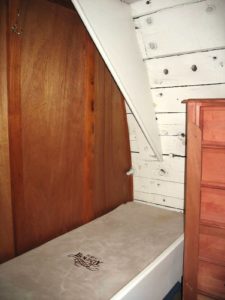 I didn’t go, of course. I didn’t even ask about it. I had a family, it cost too much money, I had commitments back home, there was no time to prepare for a trip like this, blah blah blah. But we could have swung it. My husband would have been game to parent on his own for a few days. (He’s always been game — about everything.) The truth is I was too chicken. I was afraid of getting seasick. I was afraid I would embarrass myself somehow. I was afraid of drowning.
I didn’t go, of course. I didn’t even ask about it. I had a family, it cost too much money, I had commitments back home, there was no time to prepare for a trip like this, blah blah blah. But we could have swung it. My husband would have been game to parent on his own for a few days. (He’s always been game — about everything.) The truth is I was too chicken. I was afraid of getting seasick. I was afraid I would embarrass myself somehow. I was afraid of drowning.
I contented myself with putting my name on their email list.
When the ship sank five years later, I felt so sad — for the beautiful ship, now gone, for the surviving crew and the trauma they’d experienced, for the two people who had died and everyone who loved them. I also felt regret. I wished I’d been braver back then. I wished I’d at least inquired about sailing to Monterey.
Today I have another reason for remembering Bounty. I now know someone who worked as a deckhand on the ship. Robin Beth Schaer is a gifted poet whose debut collection Shipbreaking won the 2014 Robert Dana-Anhinga Prize for Poetry. Many of the poems concern the sea, sailing, and shipwreck. It came out just a few weeks after Landfalls. Yesterday, in an e-mail exchange about a piece we’re planning to write together, she reminded me of today’s sad anniversary.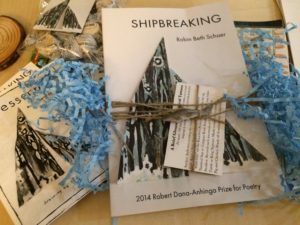
Robin has a beautiful essay at the Paris Review about living aboard and losing Bounty. And if you go to her website, you can hear a haunting recording she made below deck while the ship sailed through rough seas. The sounds of creaking timbers are ancient sounds, unnerving sounds, but also majestic, and after listening for a while, somewhat soothing in their regularity.
I wish I could have heard this while I was working on my book. There are some things no amount of research can provide.
Robin and I became acquainted through our books, and we’ll be doing some events together in the coming year, starting with a joint reading and discussion of our work at the aptly-named Morbid Anatomy Museum in Brooklyn on Tuesday, December 15. Please come if you’re in the area.
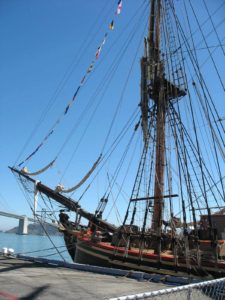 Shipbreaking includes “Shipbroken,” a poem drawn from first-hand accounts of Bounty’s sinking (Robin herself was no longer working on the ship in 2012). I can’t read it without crying. You should buy her book so you can read this poem in its entirety and the rest of this marvelous collection, but “Shipbroken” begins like this:
Shipbreaking includes “Shipbroken,” a poem drawn from first-hand accounts of Bounty’s sinking (Robin herself was no longer working on the ship in 2012). I can’t read it without crying. You should buy her book so you can read this poem in its entirety and the rest of this marvelous collection, but “Shipbroken” begins like this:
We said to stay. We said to sail.
She was safer at sea. We were not
safe at sea.
Add a Comment